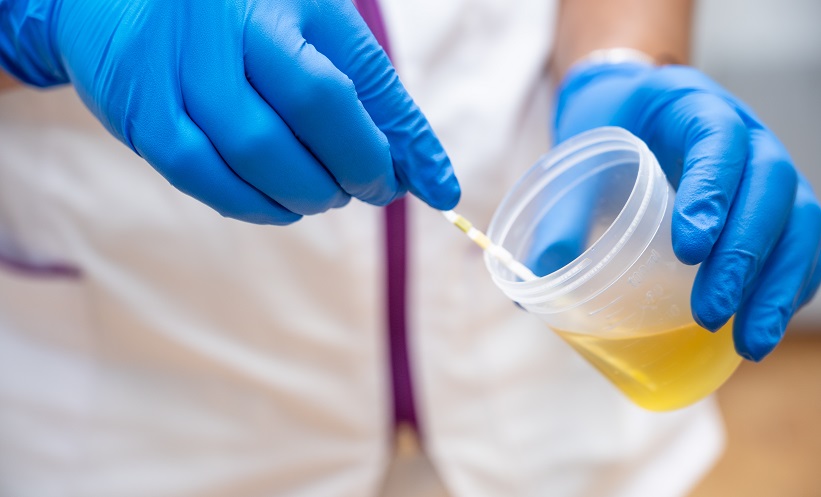Abstract
Nephrotic syndrome is a frequently encountered disease in children. It is mostly responsive to high-dose steroids, with some requiring steroid-sparing immunosuppressive regimens, or further, a renal biopsy if resistant to steroid therapy. However, nephrotic syndrome in children post-allogeneic bone marrow transplant is rarely encountered. The authors report here a child who developed nephrotic syndrome post-allogeneic bone marrow transplant for β-thalassaemia major, with the suspicion of graft-versus-host disease that was difficult-to-treat, who had frequent relapses with multiple hospital admissions, and prolonged treatment course. For the last 5 years, the disease has been in remission, on a low dose of prednisolone and mycophenolate mofetil-based maintenance immunosuppressive treatment.
Key Points
1. Patients who have had a bone marrow transplant can present with nephrotic syndrome, which can be a presentation of graft-versus-host disease.
2. After a bone marrow transplant, patients who present with nephrotic syndrome have been managed by nephrologists using conventional therapies such as prednisolone and calcineurin inhibitors.
3. This case report presents the successful management of a child post-bone marrow transplant, who presented with difficult-to-manage nephrotic syndrome while on conventional therapies. The patient was successfully manged using mycophenolate mofetil and very low dose prednisolone, and has been in remission for the last 5 years.
CASE REPORT
The authors present a case report of a child presenting with difficult-to-manage, steroid-sensitive, frequently relapsing nephrotic syndrome in the setting of a prior bone marrow transplant for β-thalassaemia major. Informed consent was duly obtained from the parents in advance of writing this case report.
A 6-year-old female presented with generalised body swelling. They were diagnosed with steroid-sensitive, frequently relapsing/steroid-dependent nephrotic syndrome in the past, and had been managed at different health facilities with repeated courses of high-dose prednisolone. Multiple immunosuppressive drugs were used in addition to prednisolone therapy, including cyclosporine, tacrolimus, and levamisole as steroid-sparing agents. The lowest dose of prednisolone required to maintain remission was 20 mg/day, along with steroid-sparing agents. On examination, the patient had bilateral gross pedal and peri-orbital oedema, with cushingoid features. The rest of their systemic examination and vital signs were normal.
Previously, the patient had been diagnosed with β-thalassaemia major, at the age of 3. In 2013, they underwent a successful allogeneic bone marrow transplant using the conditioning protocol of matched related donor bone marrow stem cell transplant, consisting of rabbit anti-thymocyte globulin-fresenius, busulfan, methotrexate, and cyclophosphamide therapy. Graft-versus-host disease (GvHD) prophylaxis was given with cyclosporine, methotrexate, and methylprednisolone. Granulocyte colony stimulating factor was administered post-transplant, with desirable blood count results.
Post-bone marrow transplant, the course was complicated by mucositis, diarrhoea, weight loss, haematuria, mood disturbance, cerebellar signs, and one instance of infection-related fever, which was treated by a course of antibiotics (ceftriaxone, amikacin, and meropenem). The patient also received two packs of red cell concentrate and nine packs of platelets during during their stay in hospital. They were discharged on ciclosporin and methylprednisolone, in tapering dose, as well as an antiviral, antifungal, pneumocystis jirovecii pneumonia prophylaxis (co-trimoxazole), and other supportive therapy.
The patient’s course remained stable for 8 months after the bone marrow transplant, after which they developed steroid-dependent, frequently relapsing nephrotic syndrome. They were managed at different centres, multiple times with prednisolone monotherapy, with subsequent additions of levamisole, and later with calcineurin inhibitors (ciclosporin and tacrolimus) and prednisolone continuously for almost 3 years.
The patient’s laboratory work-up showed a urine dipstick of 3+ proteins, with the 24-hour urinary protein test in the nephrotic range, hypoalbuminemia, and deranged lipid profile with normal renal function. They were on cyclosporine 4 mg/kg/day, with unsuccessful tapering-down of prednisolone due to relapse of nephrotic syndrome every time the steroid dose was reduced to below 20 mg/day. The patient was diagnosed with steroid-dependent, frequently relapsing nephrotic syndrome, with the possibility of GvHD as the underlying cause of the nephrotic syndrome.
Renal biopsy was not performed in this case, as the patient was diagnosed with steroid-sensitive nephrotic syndrome with steroid-dependent, frequently relapsing course. They had definite remissions on high doses of ciclosporin and prednisolone, but would relapse on dose tapering. Such patients are considered to have minimal change disease (MCD), where conventional light microscopy and immunofluorescence microscopy are normal, even if a kidney biopsy is undertaken. According to standard practice, a kidney biopsy is only performed in patients with steroid-resistant nephrotic syndrome to find underlying causes other than MCD, such as focal and segmental glomerulosclerosis, membranous nephropathy, IgA nephropathy, etc. The temporal association of steroid-sensitive nephrotic syndrome after bone marrow transplant in this patient raised the possibility of GvHD affecting the kidney and manifesting as nephrotic syndrome. However, the occurrence of steroid-sensitive nephrotic syndrome as an independent entity could not be ruled out.
Calcineurin inhibitors were stopped, considering the already protracted use without sufficient efficacy. Further options included cyclophosphamide; however, this was avoided in this case due to potential adverse consequences for the bone marrow transplant, infections, fertility, and risk of future malignancies. Instead, mycophenolate mofetil 600 mg/m2/day (weight: 25 kg; height: 4 ft; body surface area by the Du Bios method: 0.9 m2; mycophenolate mofetil 500 mg/day) was initiated. The patient was restarted on high dose prednisolone 2 mg/kg/day with gradual tapering, along with mycophenolate mofetil, with regular follow-up and frequent urine dipstick checks. Prophylactic influenza and pneumococcal vaccinations were also given, along with calcium supplements.
This patient has remained in complete remission, with no relapses since. Their prednisolone has been reduced to 5 mg on alternate days successfully. Their renal function tests, serum albumin level, and blood counts are normal, and symptoms of generalised body oedema and cushingoid features have completely disappeared. The patient has been on mycophenolate mofetil maintenance (500 mg/daily) with 5 mg prednisolone on alternate days for the last 5 years, is in complete remission, and has had no relapses.
DISCUSSION
Nephrotic syndrome, with an incidence of 1.15–16.90/100,000 children, is the most common glomerulopathy in children.1 Approximately 70–90% of children with this condition are less than 10 years of age.2 Among adults, 10–15% of patients with nephrotic syndrome have MCD as an underlying aetiology.3 In adults with MCD, 25% are found to experience a frequently relapsing course, whereas 30% develop steroid dependency.4 Clinically, nephrotic syndrome presents as massive proteinuria and hypoalbuminemia, along with oedema and hyperlipidaemia.
Food, allergen inhalation, insect bites, and vaccinations have been reported as possible aetiology.5 Recent advances in treatment regimens, especially since the 1970s, have improved overall survival and reduced mortality previously caused by complications, such as infections, thromboembolisms, and renal failure.1 Nephrotic syndrome is labelled as an idiopathic condition when there is no known underlying aetiology. In the majority of paediatric patients, idiopathic nephrotic syndrome is an MCD, which is treated with steroids. Renal biopsy is only done when idiopathic nephrotic syndrome is resistant to treatment, which in most cases turns out to be focal segmental glomerulosclerosis,6 while few can be IgA nephropathy, complement 3 glomerulopathy, or membranous nephropathy.
Kidney Disease Improving Global Outcomes (KDIGO) recommends high dose prednisolone as a first-line therapy for MCD.4 The majority of patients attain full and sustained remission,1 while some can have a chronic and relapsing course.3 For those with infrequent relapses, a short repeat course of full dose corticosteroids is recommended. However, for individuals with frequent relapses, who are steroid-dependent, or in whom steroids are contraindicated or not recommended, the addition of immunosuppressive therapy (levamisole, calcineurin inhibitors, mycophenolate mofetil, cyclophosphamide, or rituximab) as steroid-sparing therapy is recommended, in order to minimise steroid doses.7,8
GvHD is a life-threatening complication in patients after a bone marrow transplant due to immune dysregulation.9 It can be acute GvHD less than 100 days post-transplant, or chronic GvHD more than 100 days post-transplant.8 GvHD involves reconstruction failure of the central immune system in the recipient, causing the donor immune system to react against the recipient organs. There can be a loss of peripheral tolerance due to the reduction of regulatory immune cells (T, B, or natural killer cells).10 Organs such as the skin, eyes, liver, haematological system, genital and gastrointestinal tract, and rarely kidneys can be affected.9 So far, only around 50 cases of nephrotic syndrome secondary to chronic GVHD have been reported.9
Only topical treatment is sufficient in case of mild chronic GvHD. On the other hand, if chronic GvHD has multi-organ involvement, immunosuppressive treatment is a must. This includes a corticosteroid (prednisone 1 mg/kg/day) as the first-line agent, with or without a calcineurin inhibitor, allowing dose reduction of corticosteroids to avoid long-term complications of steroid use. However, 50–70% of patients develop a steroid-refractory or steroid-dependent disease. There are numerous drug options that may be considered in this group of patients.
These include high-dose steroids, mycophenolate mofetil, rituximab, methotrexate, cyclophosphamide, mammalian target of rapamycin inhibitor, and pentostatin. The latest emerging therapies include: belumosudil, a selective rho-associated protein kinase inhibitor; bortezomib, a reversible proteasome inhibitor with B cells and plasma cells inhibition property; pomalidomide, an inhibitor of T cell activation; abatacept, an inhibitor of T cell activation; tocilizumab, a humanised IgG1 IL-6 receptor antibody; ruxolitinib, an oral selective JAK1/2 inhibitor; and ibrutinib, a Bruton’s tyrosine kinase inhibitor.11,12
Literature shows how nephrologists have been using different regimens of immunosuppressant drugs to treat GvHD-causing nephrotic syndrome. In 2017, Zhang et al.13 reported a case of an adult patient who was treated for secondary steroid-resistant membranous nephropathy post-haematopoietic stem-cell transplantation (HSCT; identical sibling) for monoblastic leukaemia. Rituximab was added to cyclosporine and prednisolone. Although the proteinuria stabilised, nephrotic syndrome persisted despite albumin infusions. Mesenchymal stem cells were administered from a third-party donor (dose: 1×106 cells/kg/infusion; a total of 6 doses at weekly intervals). The patient achieved remission, with no relapses. Cyclosporine and prednisolone were tapered down and stopped. It was speculated that mesenchymal stem cells could modulate nephrotic syndrome after allogeneic-haematopoietic stem-cell transplantation by suppressing B cell proliferation (both regulatory B cells and regulatory T cells) and inhibiting inflammatory cytokine production by monocytes and natural killer cells.13
In March 2020, a survey was conducted regarding prophylaxis and treatment of acute GvHD in the paediatric population, where data was taken from European Society for Blood and Marrow Transplant (EBMT) centres in 26 countries. In paediatric patients with acute GvHD, prednisolone remained the first-line agent, at a dose of 1–2 mg/kg/day (Grade 1 or 2 involvement of the skin only). For more severe acute GvHD, intravenous methylprednisolone, at the dose of 2 mg/kg/day in two doses, was preferred. The survey showed variability in second-line treatment of acute GvHD in children, except for mycophenolate mofetil and extracorporeal photopheresis.14
In September 2020, the first case of MCD in an adult after HSCT, associated with post-transplant lymphoproliferative disorder, was reported. This patient was managed with rituximab (3 weekly doses of 375 mg/m2). The patient was continued on cyclosporine and budesonide for skin and gastrointestinal GvHD once remission was achieved with rituximab. The authors reported that membranous nephropathy caused nephrotic syndrome following HSCT in two-thirds of cases, while MCD complicated 0.4% of Hodgkin lymphoma cases.15 In 2021, another adult case was reported.10 The patient underwent syngeneic HSCT for T-lymphoblastic lymphoma and developed nephrotic syndrome 24 months later, which turned out to be atypical membranous nephropathy. This patient gained complete remission after treatment with glucocorticoids combined with cyclophosphamide and cyclosporine.10
In March 2022, a report was published regarding the management of two adult patients who developed MCD secondary to chronic GvHD after allogeneic-HSCT for myelodysplastic syndrome. The onset of nephrotic syndrome coincided with the tapering of calcineurin inhibitors in both patients. One patient had had chronic GvHD of the lungs previously. One patient was treated with corticosteroids alone, while tacrolimus was added to corticosteroids for the second patient. Complete remission was achieved in both cases with no relapse.16
The authors of this article reported a rare case of a child who developed frequently relapsing/steroid dependent, steroid-sensitive nephrotic syndrome, post-allogeneic bone marrow transplant for β-thalassaemia major, managed successfully with prolonged immunosuppressive therapy with mycophenolate mofetil and low dose prednisolone, and is still on maintenance immunosuppressive therapy for the last 5 years without any relapses.
In conclusion, steroids remain the first-line of management in both acute and chronic GvHD causing nephrotic syndrome post-bone marrow transplantation, while mycophenolate mofetil can be used as an add-on steroid-sparing agent in patients who do not respond to conventional steroid-sparing agents such as levamisole and calcineurin inhibitors. Further clinical research is recommended regarding different treatment options for MCD caused by GvHD in children, with better responses, and aiming for a shorter duration of therapy and minimal relapses. This will help achieve early remission and limit the possibility of drug-related side effects.






